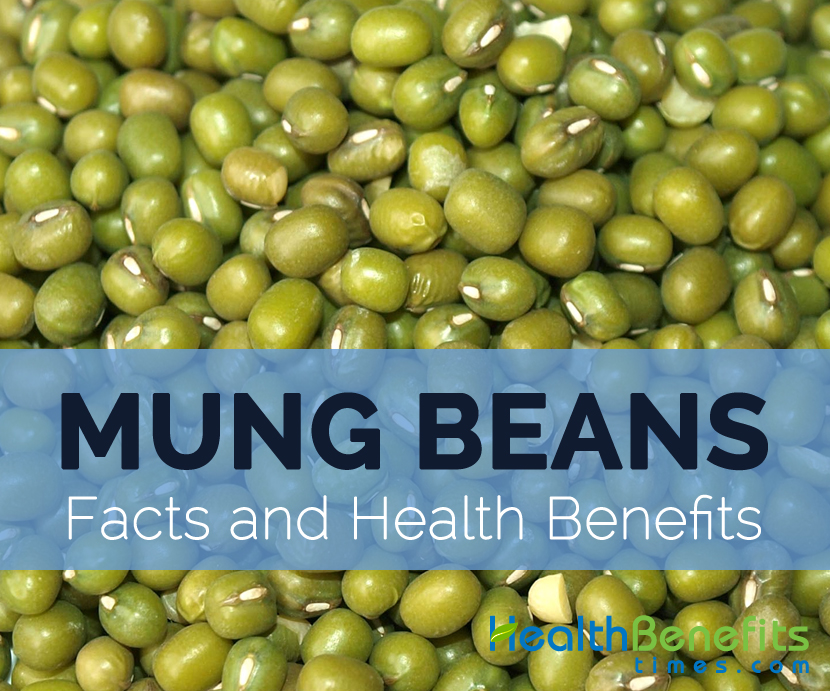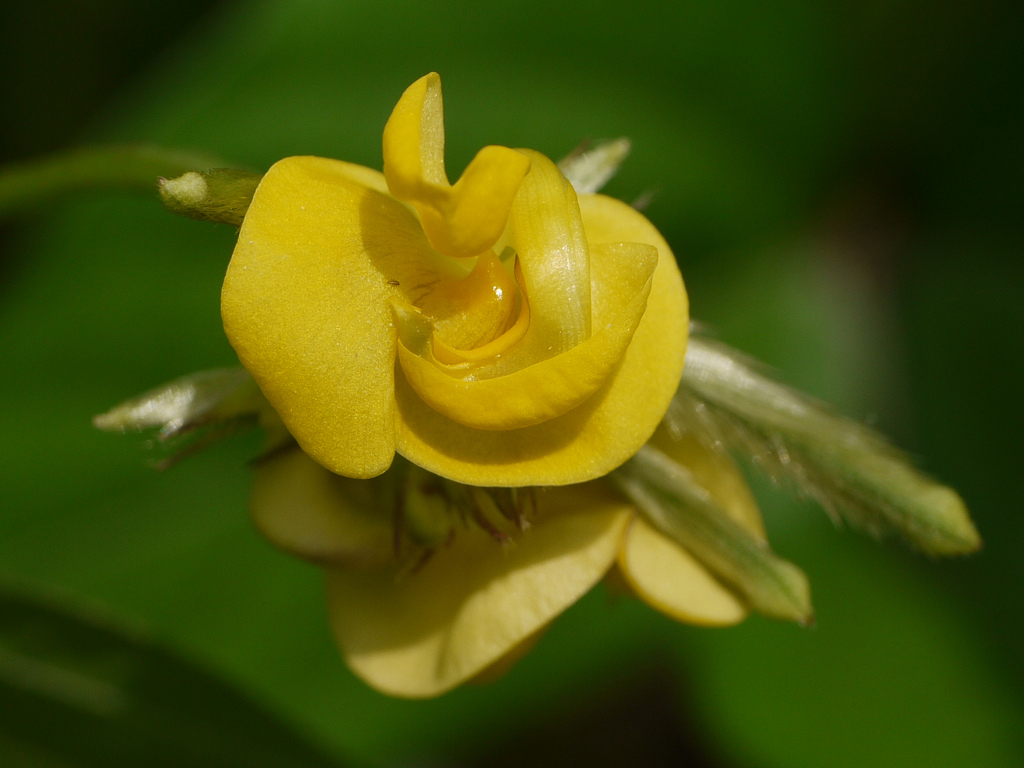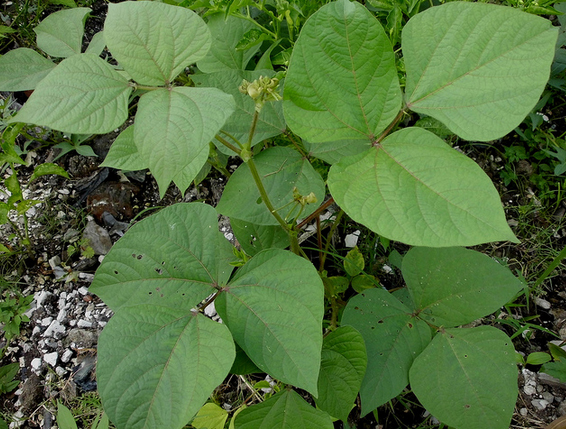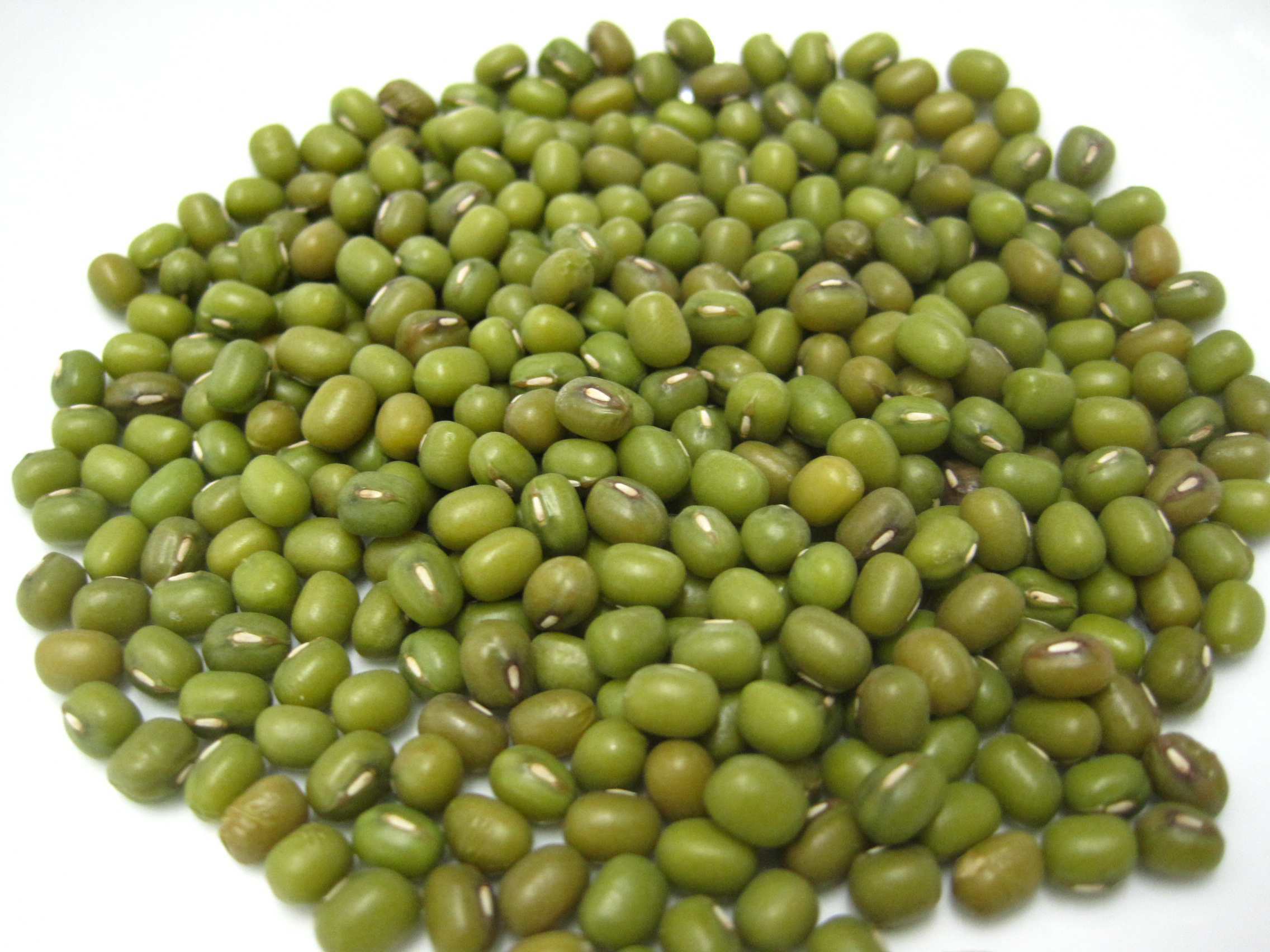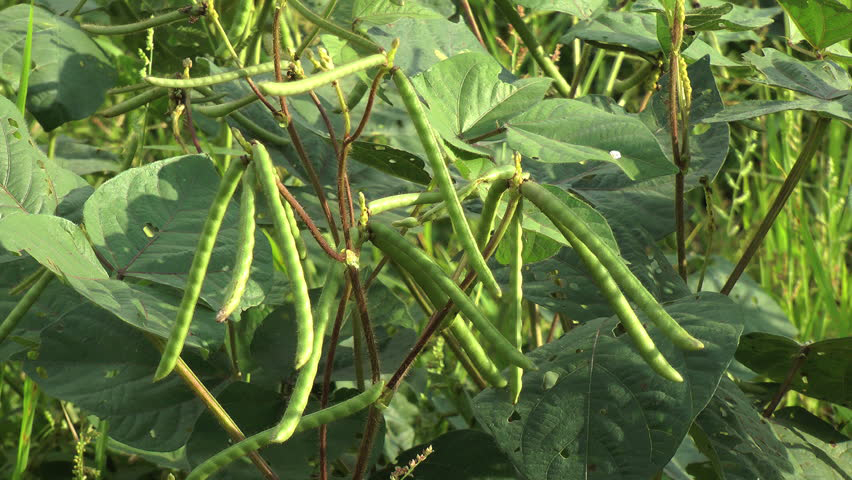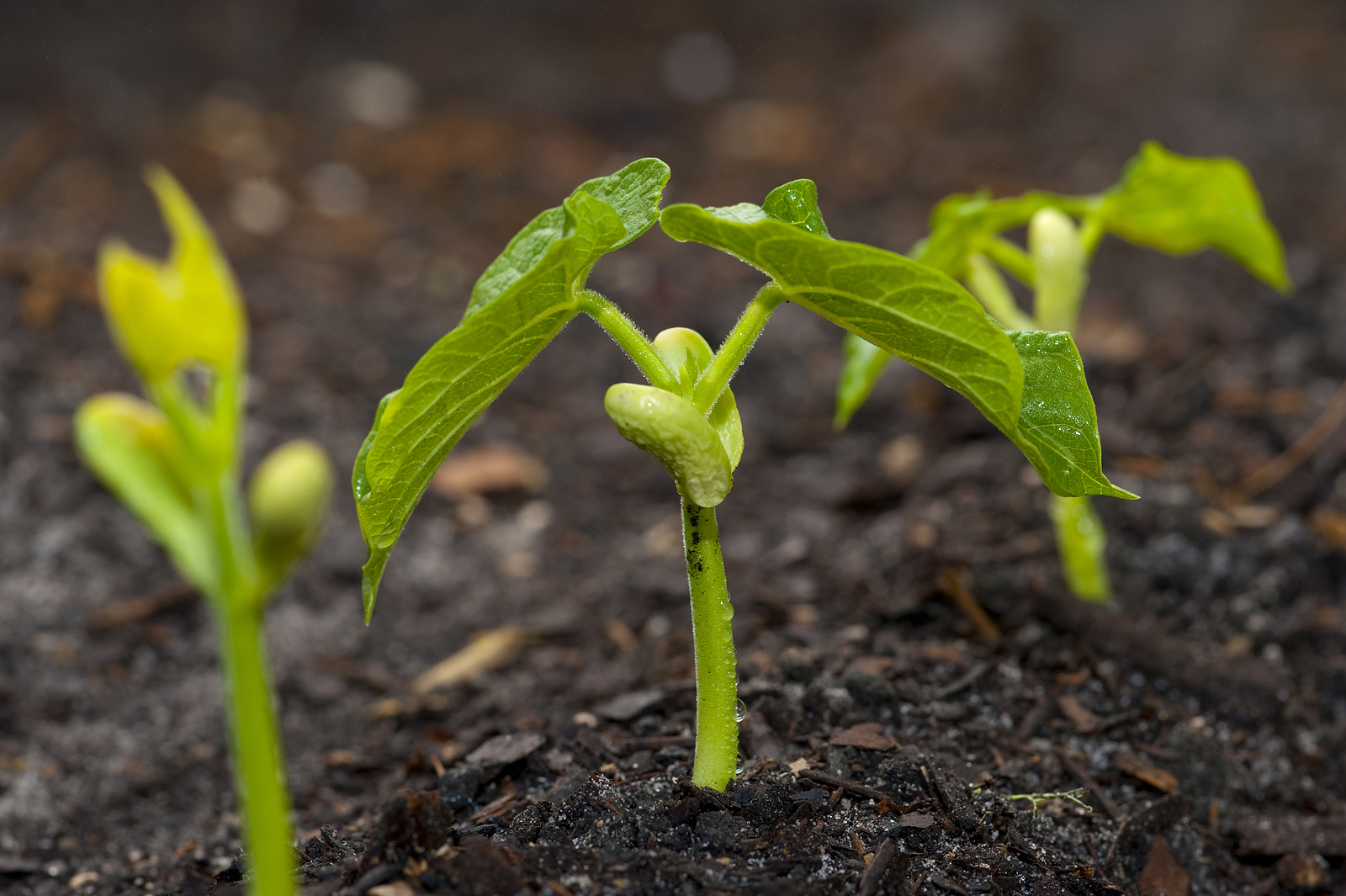History
Mung beans are native to South America. As early as 1500 BC, Mung beans were domesticated in India before it spread throughout Asia and then United States. The Mung bean was grown in India for centuries. It is also grown in South America, US, Africa, Australia and Asia.
Plant
The plant is erect or sub-erect, creeping or twining annual herb which grows upto 30–90 cm high. As a member of the legume family, Mung beans produce yellow flowers and are followed by long and cylindrical pods. Plants have trifoliate alternate leaves with elliptical-ovate leaflets. The leaves can grow upto 5-18 cm long and 3-15 cm broad. The yellow flowers develop into pendant, linear-cylindric pods of 4–12 cm long and 4–6 mm broad. The pods are black, brown and pale gray in colour. Each pod contains small subglobose or ellipsoid shaped beans. The seeds are ellipsoid upto 4–6 mm long, range widely in colors such as yellow, greenish yellow, light green, dark green, shiny green, dull green, brown, black and green often mottled with black. The seeds have got lustrous and unpolished dark green skin with light yellow flesh. The seed flavors sweet and savory. The plant has branched, weak, trailing and climbing stem of 5 m to 3 m long. The plant has deep rooted system with nitrogen fixing nodules. The season of the fruit and seeds is from summer to fall.
How to Eat
Mung Beans could be consumed cooked or sprouted. It is also served as a main dish, soup, stew or dessert. They could be consumed whole or made as flour, snacks, porridge, bread, soups, noodles and ice-cream. Split seeds can be prepared as dhal same as lentils or black gram. Mung beans could be processed as starch noodles. The extract of starch from Mung beans is used to make jellies.
Precautions
Excessive intake of Mung beans results in cold extremities, abdominal pain, fatigue, diarrhea, cold pain in legs, lower back, digestive diseases and chronic gastritis. The excessive consumption of Mung beans by the yin deficiency patients will experience swollen gums, perleche, etc. Children, pregnant women, elders and those who have weak immune system should avoid raw sprouts.
Health Benefits of Mung Beans
Mung beans possess enzymes, nutrients and antioxidants which are essential for maintaining good health. The presence of medicinal properties in the Mung beans assists to enhance the health. It is good for the health of eyes, hair, nails and liver. It also enhances the blood circulation. It is loaded with high amount of fiber and low in calories. Mung beans are used in traditional Chinese medicine for the therapeutic uses such as to detoxify body and eliminate heat.
- Prevents heart ailments
The study which was published on the Journal of Human and Experimental Toxicology shows that Mung beans have the ability to reduce bad cholesterol levels. It assists to regulate the level of cholesterol as its antioxidants eliminates free radicals, repairs the damage of blood vessels and reduce inflammation. Strokes and heart attacks are the cause of oxidized LDL cholesterols. Mung beans help to clear arteries and enhance circulation.
- Reduce blood pressure
The nutrition found in Mung beans has the ability to counteract cardiovascular diseases and high blood pressure. The study which was published in the Chemistry Central Journal shows that the extracts of Mung bean lower the level of systolic blood pressure in rats. The researcher’s reports that the anti-hypertensive effects of Mung beans lower the constricting of blood vessels that leads to raise the blood pressure.
- Prevents cancer
Mung beans possess high amount of polyphenols and oligosaccharides that assist to eliminate the development of cancer. The clinical studies show that it possesses anti-tumor properties which prevent DNA damage and mutation of dangerous cells. The study which was conducted by the College of Food Science and Nutritional Engineering at the China Agricultural University reports that the antioxidants found in Mung beans possess the free radical scavenging abilities. The flavonoids such as vitexin and isovitexin reduce the oxidative stress that leads to form cancer.
- Prevents Type 2 diabetes
The evidence shows that the nutrition found in Mung beans possess an anti-diabetic effect which helps to treat the type 2 diabetes. The study conducted by The Institute of Crop Sciences shows that when the Mung bean supplement was provided to the rats, their blood glucose, glucagon, plasma C-peptide, triglyceride level and total cholesterol was decreased but at the same time their glucose tolerance was improved with the rise in insulin responsiveness.
- Rich in protein
Mung bean seeds possess the nutrients such as isoleucine, leucine and valine which make it an effective choice for vegetarians. According to the Department of Chemistry at the Harbin Institute of Technology, the Mung beans possess 20 to 24 percentages of amino acids. Albumin and Globulin makes about 85 percent of the total amino acids which are found in the Mung beans.
- Enhance immunity
The phytonutrients found in Mung beans acts as an anti-inflammatory and anti-microbia which assists to enhance immunity and counteract the harmful bacteria, colds, viruses, irritation, rashes etc. Mung beans enhance the absorption of nutrients as well as immune defense.
- Adequate Vitamins and Minerals
Folate is essential for the DNA synthesis, tissue and cell growth, cognitive function, balance hormones and reproduction. The adequate consumption of folate is vital during pregnancy which helps to prevent neural tube defects, prevent early births and termination.
Mung beans are low in magnesium which is essential for the proper functions of heart, digestive health, release neurotransmitter and repair muscle tissues.
- Helps to lose weight
Mung beans possess high amount of protein and fiber. The researcher reports that the beans which are high in fiber increase the cholecystokinin which is a satiety hormone. The other studies show that the consumption of beans increases the satiety. The daily intake of Mung beans lowers the food intake which enhances weight loss.
- Reduce PMS
Mung beans are loaded with Vitamin B6, Vitamin B and folate which helps to control the fluctuations of hormone that leads to PMS symptoms. These assist to reduce the severity and pain related to the PMS cramps, mood swings, headaches, muscle pains and fatigue.
- Assist digestion
Mung beans are easy to digest and also help to detoxify the body. As they are rich in fiber, it assists in digestion and prevents the IBS symptoms such as constipation. In India, Mung beans are cooked with turmeric, coriander, cumin and ginger which help to add taste as well as eliminate the stomach pains.
Nutritional Value
Mung beans possess nutrients, vitamins, including dietary fiber with large amount of copper. In terms of vitamins, Mung beans contain Vitamin K, B2, B9, B3, B5, B1 and B6. As for minerals, Mung beans contain significant amounts of copper, iron, manganese, zinc, phosphorus, magnesium, potassium, calcium and sodium. It is also a good source of antioxidants such as selenium, Vitamin C, E, A and Beta carotene.
Nutritional value of Mung Beans
Calories 26 Kcal. Calories from Fat 0.99 Kcal.
| Mung beans Quick Facts | |
|---|---|
| Name: | Mung beans |
| Scientific Name: | Vigna radiata |
| Origin | South America and also cultivated in China, India and Southeast Asia. |
| Colors | Black, brown, pale gray |
| Shapes | Pendant, linear-cylindric; Length: 4–12 cm; Breadth: 4–6 mm |
| Flesh colors | Light yellow |
| Taste | Hearty and wholesome |
| Calories | 26 Kcal./cup |
| Major nutrients | Vitamin K (23.42%) Copper (16.78%) Vitamin C (15.67%) Iron (10.13%) Vitamin B2 (9.69%) |
| Health benefits | Prevents cancer, Enhance immunity, Helps to lose weight, Reduce PMS, Assist digestion |
| Proximity | Amount | % DV |
|---|---|---|
| Water | 115.8 g | N/D |
| Energy | 26 Kcal | N/D |
| Energy | 109 kJ | N/D |
| Protein | 2.52 g | 5.04% |
| Total Fat (lipid) | 0.11 g | 0.31% |
| Ash | 0.37 g | N/D |
| Carbohydrate | 5.2 g | 4.00% |
| Total dietary Fiber | 1 g | 2.63% |
| Total Sugars | 3.52 g | N/D |
| Minerals | Amount | % DV |
|---|---|---|
| Copper, Cu | 0.151 mg | 16.78% |
| Iron, Fe | 0.81 mg | 10.13% |
| Manganese, Mn | 0.174 mg | 7.57% |
| Zinc, Zn | 0.58 mg | 5.27% |
| Phosphorus, P | 35 mg | 5.00% |
| Magnesium, Mg | 17 mg | 4.05% |
| Potassium, K | 125 mg | 2.66% |
| Calcium, Ca | 15 mg | 1.50% |
| Selenium, Se | 0.7 µg | 1.27% |
| Sodium, Na | 12 mg | 0.80% |
| Vitamins | Amount | % DV |
|---|---|---|
| Vitamin K (phylloquinone) | 28.1 µg | 23.42% |
| Vitamin C (Ascorbic acid) | 14.1 mg | 15.67% |
| Vitamin B2 (Riboflavin) | 0.126 mg | 9.69% |
| Vitamin B9 (Folate, Folic acid) | 36 µg | 9.00% |
| Vitamin B3 (Niacin) | 1.013 mg | 6.33% |
| Vitamin B5 (Pantothenic acid) | 0.301 mg | 6.02% |
| Vitamin B1 (Thiamin) | 0.062 mg | 5.17% |
| Vitamin B6 (Pyridoxine) | 0.067 mg | 5.15% |
| Choline | 12.3 mg | 2.24% |
| Vitamin E (alpha-tocopherol) | 0.09 mg | 0.60% |
| Vitamin A | 1 µg | 0.14% |
| Beta Carotene | 5 µg | N/D |
| alpha Carotene | 5 µg | N/D |
| Beta Cryptoxanthin | 5 µg | N/D |
| Lipids | Amount | % DV |
|---|---|---|
| Fatty acids, total saturated | 0.031 g | 0.05% |
| Fatty acids, total polyunsaturated | 0.04 g | 0.24% |
| Palmitic acid 16:00 (Hexadecanoic acid) | 0.022 g | N/D |
| Stearic acid 18:00 (Octadecanoic acid) | 0.006 g | N/D |
| Fatty acids, total monounsaturated | 0.015 g | N/D |
| Oleic acid 18:1 (octadecenoic acid) | 0.015 g | N/D |
| Linoleic acid 18:2 (octadecadienoic acid) | 0.029 g | N/D |
| Linolenic acid 18:3 (Octadecatrienoic acid) | 0.011 g | N/D |
| Amino Acids | Amount | % DV |
|---|---|---|
| Tryptophan | 0.035 g | 7.95% |
| Isoleucine | 0.122 g | 7.30% |
| Valine | 0.12 g | 5.68% |
| Histidine | 0.064 g | 5.19% |
| Lysine | 0.153 g | 4.58% |
| Leucine | 0.161 g | 4.36% |
| Threonine | 0.072 g | 4.09% |
| Tyrosine | 0.047 g | 1.62% |
| Cystine | 0.015 g | 0.90% |
| Methionine | 0.031 g | N/D |
| Phenylalanine | 0.107 g | N/D |
| Arginine | 0.181 g | N/D |
| Alanine | 0.091 g | N/D |
| Aspartic acid | 0.44 g | N/D |
| Glutamic acid | 0.149 g | N/D |
| Glycine | 0.057 g | N/D |
| Serine | 0.03 g | N/D |


